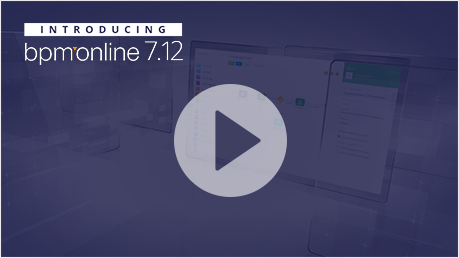Intermediate catching signal (Fig. 128) can be activated by a custom signal. It can also react to the modifying or deleting of records in the specified object.
Fig. 128 Intermediate catching signal

For example, the signal can be activated when the “VIP” status is assigned to an existing client or when deleting an activity.
Note
The “Start signal” and “Intermediate catching signal” parameter cards are identical. In contrast to the start signal, the intermediate catching signal is not activated after adding a record to an object.
Signal parameters are specified in the card (Fig. 129) that opens when an item is added to a process. You can also open this card by double-clicking the corresponding process item.
Fig. 129 [Intermediate catching event] item parameter card

In the [Caption] field, enter the caption of the process item that will be displayed in the diagram.
Select the [Catch custom signal] option if the intermediate catching signal must react to a signal with the specified name. When this option is selected, the [Signal] field becomes editable. When executing the intermediate throwing signal, the catch custom signal can be generated in the current process, as well as in a different one.
Use the [Signal] field to specify the name for the signal that the given event will wait for. When this signal is received, the outgoing sequence flow will be activated. The [Signal] field is editable only if the [Catch custom signal] option is selected.
Select the [Catch object-related signal] option to catch a certain event that occurs in an object. Adding, editing or deleting a record of an object can be a such event for the start signal, but only editing and deleting – can be an event for the intermediate catching signal.
Use the [Object] field to select the object in which the event will occur. For example, for the signal to catch the modification of an account status in the system, specify the “Account” object.
The [Event] field indicates the type of event in the object. The following types are available:
•The [After adding record] event is activated after a new record is added in the object, for example, when registering a new account, adding a new task or call. This event is only available in the start signal card.
•The [After editing record] event will catch any modifications made to a record in the object. For example, such events include changing a contact or account category, activity status, etc.
•The [After deleting record] event will be activated after a record is deleted in the object. For example, this could be the deletion of a knowledge base article, customer, activity, etc.
Use the [Object record] field to specify the record, which, if edited, will cause a signal activation. For example, a signal can be activated when editing an activity created earlier in the process. This field is available in the intermediate catching signal card only. In contrast to the intermediate catching signal, the start signal is activated after the editing of any record in the object.
Select the [Object must meet the following conditions] checkbox if the added, edited or deleted record must meet filter conditions. Use the standard filter area to design the needed filter. If the checkbox is selected:
•The start event starts after adding, editing or deleting a record that meets the filter conditions. For example, according to the specified conditions the event will occur only if a contact of a certain type is added to the system, an account is assigned a certain status, or an activity is scheduled for certain period.
•The intermediate event starts after the editing or deleting of the selected record that meets the filter conditions, for example, a certain account is assigned the “VIP” status.
The [Object must meet the following conditions] checkbox and filter area become available when the [Object] field is filled in.
Select the [At least one of the following columns must be changed] checkbox to specify the columns, which will trigger the event when changed. If the checkbox is not selected, an event will be activated after editing any object column. After the checkbox is selected, the list of columns below it becomes active. Use the [Add] and [Remove] buttons to manage the list of columns. This checkbox becomes active if the [After editing record] value is specified in the [Event] field.
See also






